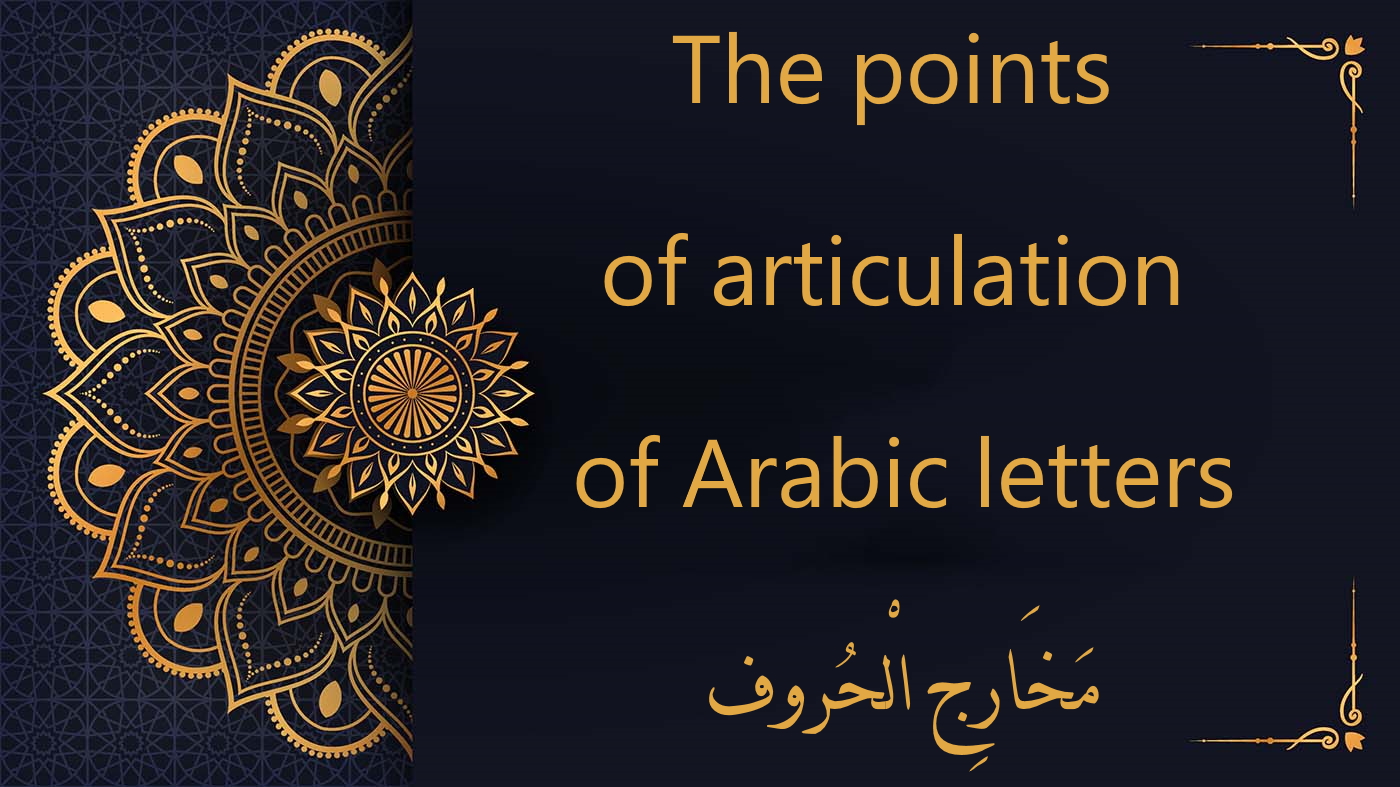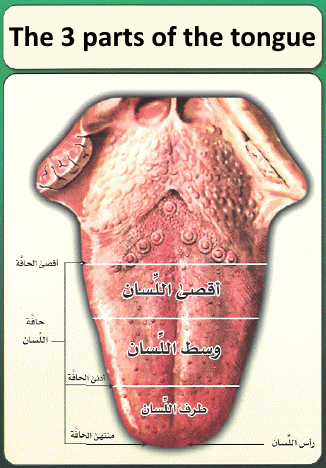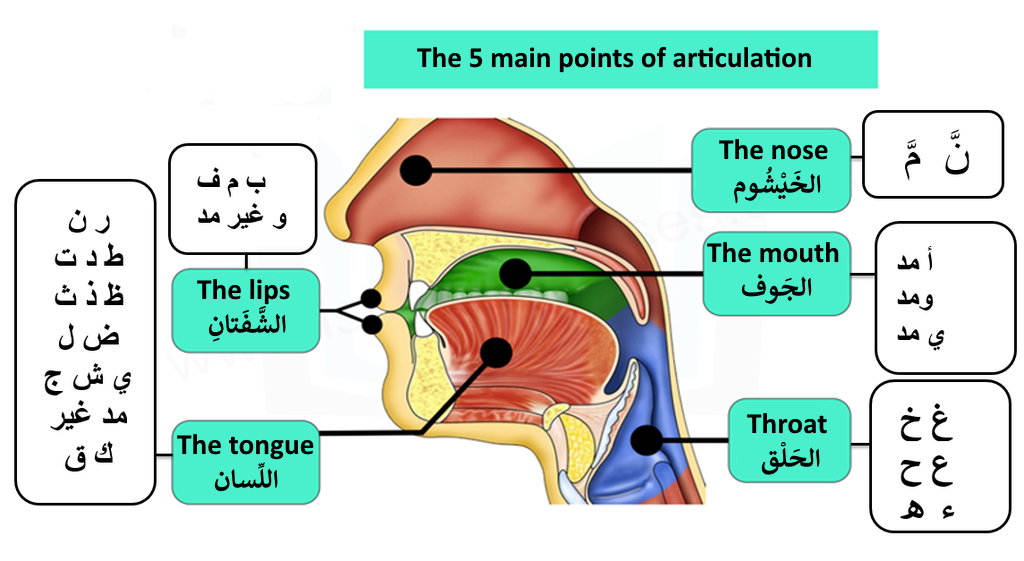
Articulation Points of Arabic Letters: مخارج الحروف
For those eager to recite the Holy Qur’an precisely as it was revealed to Prophet Muhammad (peace be upon him), understanding the articulation points of Arabic letters is crucial. Dedication to the mastery of each letter’s pronunciation and articulation ensures the true essence of the word is captured. In simpler terms, the articulation point is the precise location from which the letter’s sound emerges.
In Arabic, this point of articulation is termed ‘makhraj’ (مَخْرَج), with its plural being ‘makharij’ (مَخَارِج). The term stems from the Arabic root خَرجَ, translating to “he exited.”
Scholars have differing opinions on the exact number of these articulation points. Some propose there are 16, others say 14. We align with esteemed grammarian Al Khalil and several tajweed specialists, like Ibn Al Jazari, who identify 17 makharij.
The Arabic script comprises 28 letters, and adding the ‘alif’ (ا) brings the count to 29. Broadly, these letters can be categorized into:
- Asliya (أَصْلِية) – Denoting the primary or original letters, this category encompasses the 29 standard letters of the Arabic alphabet.
- Far’iyya (فرْعِية) – These are composite letters, formed by combining two primary letters. Their articulation tends to shift between two distinct points.
Principal Articulation Points of Arabic Letters
The 17 makhârij can be categorized into five primary phonation locations:
- The oral cavity (or inner space of the mouth) – الجَوف: For these letters, there isn’t a specific point of origin; rather, the location is approximated.
The other four distinct articulation points (makharij) are:
- The throat – الحَلْق
- The tongue – اللِّسان
- The lips – الشَّفَتانِ
- The nasal passage – الخَيْشُوم”
1. The oral cavity - الجَوف
Al Jawf – الجَوف: Refers to the oral cavity or inner space of the mouth. From this region emanate the elongation letters, namely:
- The ا, producing the sound “a” when it has a sukoon and is preceded by a fatha.
- The و, producing the sound “oo” when it has a sukoon and is preceded by a damma.
- The ي, producing the sound “ee” when it has a sukoon and is preceded by a kasra.
These letters are highlighted in the Holy Qur’an in the following verse segment:
تِلْكَ مِنْ أَنبَاءِ الْغَيْبِ نُوحِيهَا إِلَيْكَ
That is from the news of the unseen which We reveal to you (11:49)
The letters emanating from the al jawf (inner space of the mouth) are unrestricted in their pronunciation, with the sound ceasing only when one’s breath runs out.
The exact articulation point for these letters is more generalized rather than specific, as they rely heavily on airflow.
They are also referred to as al huruf al hawa’iyya – الحُرُوفُ الهَوَائِيَّة, which alludes to their airy nature.
Note: It’s crucial to remember that these three letters (alif ا, wâw و, and yâ ي) should exclusively be pronounced from the mouth; the nasal passage doesn’t play a role in their articulation.
2. The throat - الحَلْق
The throat includes 3 exit points:
- أَقْصَى الحَلْق –aqsâ al-halq: the back of the throat
- وَسَطُ الحَلْق – wasat al-halq: the middle of the throat
- أَدْنَى الحَلْق –adnâ al-halq: the entrance to the throat.
A. Adnâ al-halq - أَقْصَى الحَلْق: The innermost part or the entrance of the throat
This area corresponds to the region around the larynx. From this location, two letters are articulated: the hamza ء and the hâ ه.
Examples:
وَلَا يُحِيطُونَ بِشَيْءٍ مِّنْ عِلْمِهِ إِلَّا بِمَا شَاءَ
and they encompass not a thing of His knowledge except for what He wills (2,255)
قُلْ هُوَ اللَّـهُ أَحَدٌ
Say, “He is Allah, [who is] One
B. وَسَطُ الحَلْق -wasat al-halq : the middle of the throat
This area is situated at the pharynx, near the glottis. The letters ‘ayn ع and Hâ ح are articulated from this location.
Examples:
إِيَّاكَ نَعْبُدُ وَإِيَّاكَ نَسْتَعِينُ
It is You we worship, and You we ask for help. (1:5)
بِسْمِ اللَّـهِ الرَّحْمَـٰنِ الرَّحِيمِ
In the name of Allah, the Entirely Merciful, the Especially Merciful. (1:1)
C. أَدْنَى الحَلْق -adnâ al-halq: the entrance to the throat
This section is nearer to the mouth. The letters ghayn غ and khâ خ originate from this point.
Examples:
صِرَاطَ الَّذِينَ أَنْعَمْتَ عَلَيْهِمْ غَيْرِ الْمَغْضُوبِ عَلَيْهِمْ وَلَا الضَّالِّينَ
The path of those upon whom You have bestowed favour, not of those who have evoked [Your] anger or of those who are astray. (1:7)
وَهُمْ فِيهَا خَالِدُونَ
and they will abide therein eternally. (2:25)
Note: The letters غ and خ require emphasis, as they are strong letters. This entails a fuller mouth resonance when pronouncing them.
3. The tongue- اللِّسان
The tongue comprises 10 distinct articulation points, giving rise to 18 letters:
- The farthest part of the tongue (aqsâ al-lisan) against the pharynx and upper palate is the articulation point for the letter qâf ق.
- Just below the qâf’s articulation point, where the upper part of the tongue meets the upper palate, is where the kâf ك emerges. The letter qâf ق is positioned nearer to the throat.
- The middle of the tongue (wast al-lisan) meeting the upper palate produces the letters djîm ج, shîn ش, and yâ ي (when yâ acts as a consonant, not a long vowel). Remember to pronounce ج as “djîm,” not “jîm.”
- The side (or sides) of the tongue pressing against the upper premolars and molars articulates the unique dâd ض. Arabic is often referred to as “the language of ض” since this letter is exclusive to Arabic and among the most challenging to pronounce.
- One edge of the tongue’s tip against the palatal mucosa provides the pronunciation for the letter lâm ل.
- Slightly above the position for lâm, where the tongue’s tip presses the palatal mucosa, is the point for the noûn ن.
- Just below the noûn’s point, where the tip pushes against the palatal mucosa while also causing the tongue’s rear to vibrate, is where the râ ر is articulated.
- The tongue’s tip against the palatal mucosa of the upper central incisors articulates the letters ta ت, dâ د, and Tâ ط.
- The tip, combined with the part separating the lower central incisors, shapes the sounds for sâd ص, shîn ش, and zey ز.
- By resting the tip of the tongue against the tip of the upper central incisors and slightly protruding it between the teeth, the letters Zâ ظ, dhâl ذ, and thâ ث are pronounced.

4. The lips - الشَّفَتانِ
The lips serve as the articulation points for two makharij:
- The inner part of the lower lip pressing against the upper central incisors creates the sound for the letter fâ ف.
- The space between the lips forms the sounds for the letters wâw و (when acting as a consonant and not a long vowel), ba ب, and meem م.
Note:
The role of the lips in pronunciation is crucial, extending beyond the above-mentioned letters. Overlooking the position of the lips can result in mispronunciation.
For instance, while articulating the kasra, it’s essential to elongate the mouth horizontally (akin to a smile) to produce a clear “i” sound that doesn’t resemble an “è.” Proper articulation is key.
5. The nasal cavity - الخَيْشُوم
The nasal cavity plays a role in producing what’s known as the nasal resonance or ghunna (الغُنّة). This characteristic sound is particularly evident when pronouncing the letters noon ن and meem م when they have a shadda (ّ) over them. The ghunna is also present when the noon ن, meem م, or tanween is in a state of sukoon, but this occurs under specific conditions.
6. The intermediary articulation points - فرْعِية
These letters have a point of articulation that varies between two distinct places. In the Holy Qur’an, according to the recitation method of Imam Hafs, there are four such letters:
- Alif الممالة (alif al-mumala) – the receding alif
- Lâm المفخمة (lâm al-mufakhama) – the emphasized lâm
- Hamza المسهلة (hamza al-musahhala)
- Al-Ishmam
Each of these letters has its unique pronunciation nuances depending on its surrounding letters and conditions.
Al-alif al-mumala (declining alif) - الأَلِفُ الْمُمَلَ
This rule is also termed “al-imala as-sughra.” Technically, the pronunciation of the letter should strike a balance between the sounds of fatha and kasra. In the recitation method of Hafs, there exists just one instance of this in the Holy Qur’an:
وَقَالَ ارْكَبُوا فِيهَا بِسْمِ اللَّـهِ مَجْرَاهَا وَمُرْسَاهَا
And [Noah] said, “Embark therein; in the name of Allah is its course and its anchorage. (11:41)
Note: In some copies of the mushaf, there is a diamond below the letter on which the rule of al imâla sughra must be applied. For example:

Al-lâm ل al-mufakhama (the emphasized lam)
The emphasized lam (ل) refers to the pronunciation of the lam in the divine name when it is preceded by either a fatha or a damma.
Example:
وَمَا اللَّـهُ بِغَافِلٍ عَمَّا تَعْمَلُونَ
And Allah is not unaware of what you do. (2:85)
Al-hamza ء al-musahhala
The transitional hamza sits between the hamza ء and the alif ا in its sound. In the Hafs recitation, this unique pronunciation of the hamza can be found only once in the Holy Qur’an.
أَأَعْجَمِيٌّ وَعَرَبِيٌّ
Is it a foreign [recitation] and an Arab [messenger]? (41:44)
Note: In some copies of the mushaf, there is a black point that shows us that we must apply the rule of al hamza musahhala:

Al-ishmam
Technically, it involves creating a shaping of the lips as if pronouncing the “oo” sound of the damma, yet without producing any audible sound. This action is noticeable only to someone observing the reciter closely.
In the Hafs recitation, this pronunciation can be found in the following verse:
قَالُوا يَا أَبَانَا مَا لَكَ لَا تَأْمَنَّا عَلَىٰ يُوسُفَ وَإِنَّا لَهُ لَنَاصِحُونَ
They said, “O our father, why do you not entrust us with Joseph while indeed, we are to him, sincere counsellors? (12:11)
Note: In some copies of the mushaf, there is a diamond above the letter to which the rule of al ishmam must be applied:

Conclusion
This lesson on tajweed rules has come to a close. Insha’Allah, our next lesson will delve into the characteristics of Arabic letters.
At Al-dirassa Institute, we provide opportunities to learn tajweed rules seamlessly under the guidance of qualified teachers. Should you have an interest, we welcome you to get in touch with us.
Chosen and Trusted by Thousands of Satisfied Learners
Discover the experiences of our delighted clients who have thoroughly enjoyed utilizing this standout feature.
Alhamdulillah I‘m very pleased with the arabic and Qur’an lessons I receive from teacher Umm Tasneem and I‘m also content with the al-dirassa administration team who were very quick in answering any questions I had. In a month I progressed a lot and I cannot wait to continue my studies with al-dirassa. May Allah reward everyone at al-dirassa.
 Verified review - view original
Verified review - view original
My Qur’an teacher is fantastic, she teaches me in a loving and kind way where I look forward to the lessons and learn so much. My Arabic teacher is equally as nice and has a lot of patience with me, she has great expertise in the field and I’ve progressed really quickly with her. Thank you Al-dirassa!
 Verified review - view original
Verified review - view original
Book your free trial lesson
Don’t want to go through the translation anymore?
30 free minutes with your qualified Egyptian teacher.





